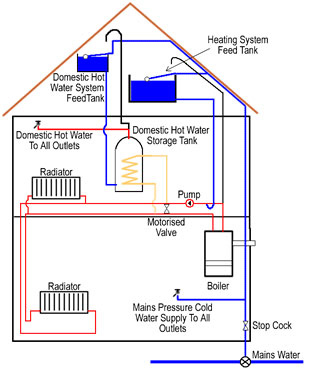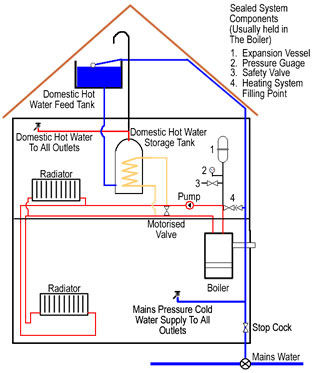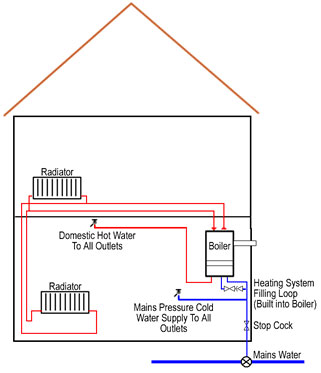High Efficiency Boilers
This page will tell you All About Boilers and describe the types of installation. As of April 2005 in England and Wales, with very few exceptions, it is a requirement under Part ‘L’ of the building regulations, that new and replacement boilers should be High efficiency (HE) condensing boilers, with an efficiency of no less than 86%.
Modern boilers convert 90% of their fuel into heat compared to 78% on conventional boilers. To put that into more comparable terms, the exhaust fumes from a conventional boiler exiting the flue outside will be on average around 150-180 degrees! Compare this figure with 50-60 degrees from a condensing boiler flue. That’s about 100 degrees of wasted heat that could be used for heating the water in your heating system, rather than warming the flies outside! Compared to existing boilers they use 30-40% less fuel; a condensing boiler’s high operating efficiency capabilities are made possible by a completely different design approach to the combustion and heat transfer process. With larger heat exchangers or sometimes two heat exchangers, their design ensures that as much heat as possible is transferred from the burner and as little as possible is lost in gases through the flue.
The visual proof, apart from your gas bill, of the amount of energy drawn from the flue gas, is the appearance of ‘Pluming’ from the flue which is a good visual sign that the boiler is working to its maximum potential. Pluming is a mist caused by the flue gases turning to a water vapour due to the lower flue gas temperatures produced by the heat transfer process in the boiler. The majority of the water vapour produced ‘Condensate’ runs down through the boiler and is discharged to a local drain line via a waste line. This is an additional pipe required compared to conventional boilers.
It is no surprise then, that one of the most effective ways of reducing your energy bills is to replace an old or inefficient boiler with a HE condensing boiler. Replacing that old inefficient boiler may not seem a cost effective way of reducing your fuel bills, but lower heating bills can help recover the cost within 3-5 years and the savings continue long after. A new Condensing boiler and controls upgrade could produce fuel cost savings of between £190 – £240 annually. There are three main types of boiler, which are:
- Open vented boiler
- System boiler
- Combination boiler
If everyone in the UK with gas central heating installed a HE boiler, we would preserve enough energy to heat 3.4 million homes for a whole year and save around 13 million tonnes of CO2 emissions.
Conventional Heating Systems
This type of system has a reservoir of cold water in the loft called a storage tank that feeds a hot water cylinder store in the airing cupboard. There is also a smaller tank called a header tank in the loft that tops up the heating water .
The boiler heats up the hot water cylinder via a coil inside and also the heating system. The heat up time of the cylinder depends on the size of the tank but on average it can take between 30-60 minutes to heat the cylinder up from cold. The disadvantages to this type of system are the heat losses from the pipework to and from the boiler and cylinder and the cylinder itself.

Sealed System
This type of system adopts the same set up as the conventional system. The only difference is that the heating system is sealed, not open to atmosphere via a vent. The boiler comes with all components fitted inside which are an expansion vessel (which replaces header tank), pressure gauge, pressure relief valve and a pump. This type of system is manually filled via a filling loop which is a braided hose connected between the water main supply and heating system. The system is filled until a pressure of 1-1.5 bar is observed on the pressure gauge. The pressure relief valve takes the place of the open vent of the conventional system and is connected to a pipe that terminates externally, which will discharge at a pressure of 3 bar to protect system components.

Combi Boiler Heating Systems
Combination boilers are a popular choice in flats and small houses. The advantages of a combination boiler are the saving of space due to the fact that there is no need for any loft tanks or hot water cylinder and instant hot water.
Combination boilers contain all necessary components within the boiler. Combination boilers adopt the sealed system arrangement explained above. Combination boilers are supplied directly from the water mains and hot water is heated instantaneously as it passes through the boiler. Hot water is heated on demand as opposed to the systems above which require timing for pre-heating of hot water before use.
The disadvantage of combination boilers are limitations to hot water supply, no back up like an immersion heater on a cylinder and larger volumes of gas required to heat water instantly.
It is a good idea to fit an electric shower as a backup in the event of boiler failure.

For more information visit our boiler install and service page Read More
Contact Us
To get a FREE no-obligation quote, call Tel: 01202 386439 or Mobile: 07887 647921 now or complete our online enquiry form.
